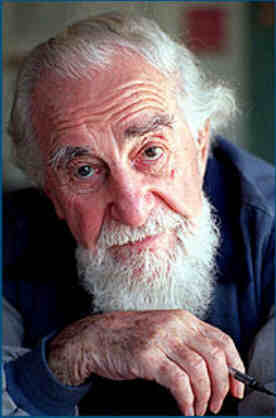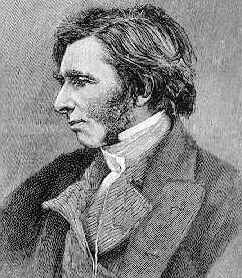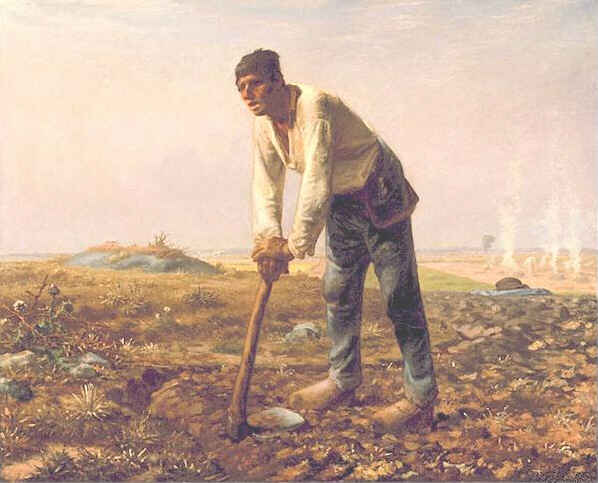
—
Al Hirschfeld's caricatures captured the vivid personalities of entertainers
and their performances for more than 75 years.
He drew a vast and imaginative portrait
of the performing artists of his lifetime, particularly in the theater.
He was a familiar figure at first nights and at rehearsals, where he had
perfected the technique of making a sketch in the dark, using a system
of shorthand notations that contributed to the finished product.
His art was compared by critics to that
of Daumier and Toulouse-Lautrec but, ultimately, it was Hirschfeld, cannily
perceptive, wittily amusing and benignly pointed.
Hirschfeld's art was distinguished by his
deep feeling for people. He never went for the jugular, except on one
occasion, when he did an ironic drawing of David Merrick, the producer,
as a demonic Santa Claus. Merrick, to Hirschfeld's mixed reaction, liked
the image so much that he bought it and used it on his Christmas cards.
Hirschfeld continued to work until his
death. On Saturday 18 January 2003, as usual, he was at work in his studio,
drawing the Marx brothers, all of whom were his friends.
In 1996 a film documentary of the artist's
life was made by Susan W. Dryfoos: The Line King.
Hirschfeld was best known for the caricatures
that appeared in the drama pages of The New York Times. But his
work also appeared in books and other publications and is in the collections
of many museums. His other artistic work often reflected his travels to
the South Pacific and to Japan, where he was deeply influenced by aesthetics
and techniques.
Hirschfeld's reinventions caught the spirit
of their subjects with lines that, studied individually, might seem irrelevant
but, taken together, added up to characteristic eyes, hairdos and motions
— all in such a way as to distill the character of his subject.
Dancer Ray
Bolger's portrait shows him as a bumbling magician dancer. Barbra
Streisand in “Funny Girl” looks birdlike, all points,
with wide-open mouth and lidded eyes. Zero
Mostel as Tevye in “Fiddler on the Roof” appears
as a circle of beard and hair with fierce eyes peering upward, as at a
heaven that did not understand.
Hirschfeld was a lively, white-haired,
white-bearded man 1m73 tall, who saw himself this way: “A couple
of huge eyes and huge mattress of hair. Large eyes with superimposed eyebrows.
No forehead. The forehead that you see is just the hair disappearing.”
In the 1930's and 40's Hirschfeld wrote
pieces on comedians, actors, Greenwich Village and films for The NY
Times. In one he sharply criticized Snow White, Walt Disney's
animated movie, for imitating “pantographically” factual photography
and for being in the “oopsy-woopsy school of art practiced mostly
by etchers who portray dogs with cute sayings.”
 Albert Hirschfeld was born in St. Louis, one of three sons of Isaac and
Rebecca Hirschfeld.
Albert Hirschfeld was born in St. Louis, one of three sons of Isaac and
Rebecca Hirschfeld.
When he was 12 years old and had already
started art lessons, the family moved to New York City. He attended public
schools and the Art Students League. By 18, he was art director for Selznick
Pictures. In 1924 he went to Paris where he continued his studies in painting,
sculpture and drawing.
It was during a trip to Bali — where the
intense sun bleached out all color and reduced people to “walking
line drawings”, as he later recalled — that he became “enchanted
with line” and concentrated on that technique.
While on a visit to New York in 1926 from
Paris, he went to the theater one evening with Richard Maney, a press
agent who was handling his first show, a production that starred Sacha
Guitry, the French star, in his first US performance. With a pencil, Hirschfeld
doodled a sketch in the dark on his program. Maney liked it and asked
Hirschfeld to repeat it on a clean piece of paper that could be placed
in a newspaper. It appeared on the front page of The New York Herald
Tribune, which gave him more assignments.
Some weeks later, the artist received a
telegram from Sam Zolotow of The NY Times's drama department
asking for a drawing of Harry Lauder, who was making one of his numerous
farewell appearances. Hirschfeld delivered it to the messenger desk at
the newspaper. A few weeks later, he had another assignment from The
NY Times.
This went on for about two years, he later
recalled, until he first met Zolotow in a theater lobby. He was told to
deliver his next drawing in person, and he did, making the acquaintance
of Brooks Atkinson, then The NY Times's drama critic, who became
a close friend. Hirschfeld was never a salaried employee of The NY
Times but worked on a freelance basis that left ownership of his
work in his hands after it had been published in the newspaper.
He applied his art to other subjects elsewhere.
In the 1920's and early 30's, imbued with a sense of social concern, Hirschfeld
did serious lithographs that appeared, for no fee, in The New Masses,
a Communist-line magazine. Eventually, he realized that the magazine's
interest was politics rather than art. After a dispute about a caricature
he had made of the Rev. Charles E. Coughlin, the right-wing, anti-Semitic
radio priest, the artist renounced a political approach to his work and,
in his The World of Hirschfeld, later wrote, "I have ever since
been closer to Groucho Marx than to Karl."
The Hirschfelds' daughter, Nina, was born
in 1945. On 05 November of that year, her name made its debut in the pages
of The NY Times, on an imagined poster in a circus scene for
a drawing about a new musical, Are You With It? Thereafter Nina's
name would covertly insinuated into a caricature one or several times
— perhaps in the fold of a dress, a kink of hair, the bend of an arm.
So popular did the Ninas become that the
military used them in the training of bomber pilots to spot targets. A
Pentagon consultant found them useful in the study of camouflage techniques.
Hirschfeld realized how addicted readers had become to Ninas when he purposely
omitted them one Sunday only to be besieged by complaints from frustrated
Nina hunters.
One Nina fan was Arthur Hays Sulzberger,
then the publisher of The NY Times. In 1960 he wrote a letter to Hirschfeld
to say that he always first looked for Ninas in Hirschfeld drawings but
had learned that each included more than one. “That really isn't
fair, since not knowing how many there are leaves one with a sense of
frustration,” Sulzberger wrote.
A letter from another reader suggested
that the artist note in the caricature how many times a Nina appeared.
From that time on, Hirschfeld appended the number of Ninas in the lower
right-hand corner of each drawing (omitted in lithographic reproductions).
Hirschfeld believed that acceptance of caricatures was a slow process
and one that was always difficult for the artist. Occasionally actors
and producers hinted at lawsuits or withdrawal of advertising because
they did not find his drawings sufficiently attractive.
But his art flourished and endured, and
it sometimes seemed as if there were Hirschfelds at every point of the
compass. He was represented for more than a quarter of a century by the
Margo
Feiden Galleries, which once estimated that there were more than 7000
Hirschfeld originals in existence. One that is no longer in existence
is a Hirschfeld self-portrait reproduced in paint on Madison Avenue between
62nd and 63rd Streets, in front of the gallery in 1994. It was 14.6 m
long, complete with Ninas, and survived a partial washout by rain the
first day.
In 1991 the United States Postal Service issued
Comedians
by Hirschfeld, a booklet of five 29-cent stamps honoring comedians
— Stan Laurel and Oliver Hardy, Edgar Bergen and Charlie McCarthy, Jack
Benny, Fanny Brice and Bud Abbott and Lou Costello — as designed by the
artist; contrary to post office policy forbidding secret marks, he was
allowed to insert his trademark Ninas into the depictions.
In the early 1940's he and a close friend,
the writer S. J. Perelman, collaborated on a musical with Ogden Nash and
Vernon Duke: Sweet Bye and Bye and opened and closed in Philadelphia
on the same night.
Subsequent travels resulted in books —
words by Perelman, pictures by Hirschfeld — like Westward Ha! or Around
the World in 80 Clichés and Swiss Family Perelman.
In 1995 appeared the CD-ROM, Hirschfeld:
The Great Entertainers.
Dolly Haas Hirschfeld was his 2nd wife,
adviser and social director from 1942 to her death 1994. An earlier marriage
to Florence Ruth Hobby ended in divorce. In 1996 he married Louise Kerz,
a research historian in the arts and a longtime friend, who survives him.
He is also survived by his daughter, Nina Hirschfeld West of Austin, Texas.
In something of a self-criticism, Hirschfeld,
in a letter to The NY Times in 1986, expressed his opinion about
an article in the Science section on defining beauty. “Beauty is
incapable of being defined scientifically or aesthetically. Anarchy takes
over. Having devoted a long life to the art of caricature I have rarely
convinced anyone that caricature and beauty are synonymous. Beauty may
be the limited proportions of a classic Greek sculptured figure but it
does not have to be — it could be an ashcan.”

— Author of The World of Hirschfeld (1970) —
Show Business Is No Business — The American Theater as Seen
by Hirschfeld — Hirschfeld on Line (1999) — Hirschfeld's
New York — Hirschfeld's Hollywood — The Speakeasies of 1932
— Hirschfeld's Harlem.
— Hirschfeld
Gallery
— Self
Portrait, Absolut — Self Portrait, Inkwell [>>>]
— Self
Portrait at 86 — Self
Portrait at 89 — Self
Portrait at 90 — Self
Portrait at 98 — Self Portrait at 99 [above, left, extra
hand added] — Self
Portrait in Barber's Chair — The
Artist with his wife Louise Strolling Through the World's Greatest City
— Houdini
(2002) — Bill
Gates (2000) — Puccini
(2000, 68x53cm) — Tchaikovsky
(1991) — Democratic
Presidential Candidates (1988) — The
Taj Mahal, A Tourist Eye's View (1947) — Alfred
Hitchcock

